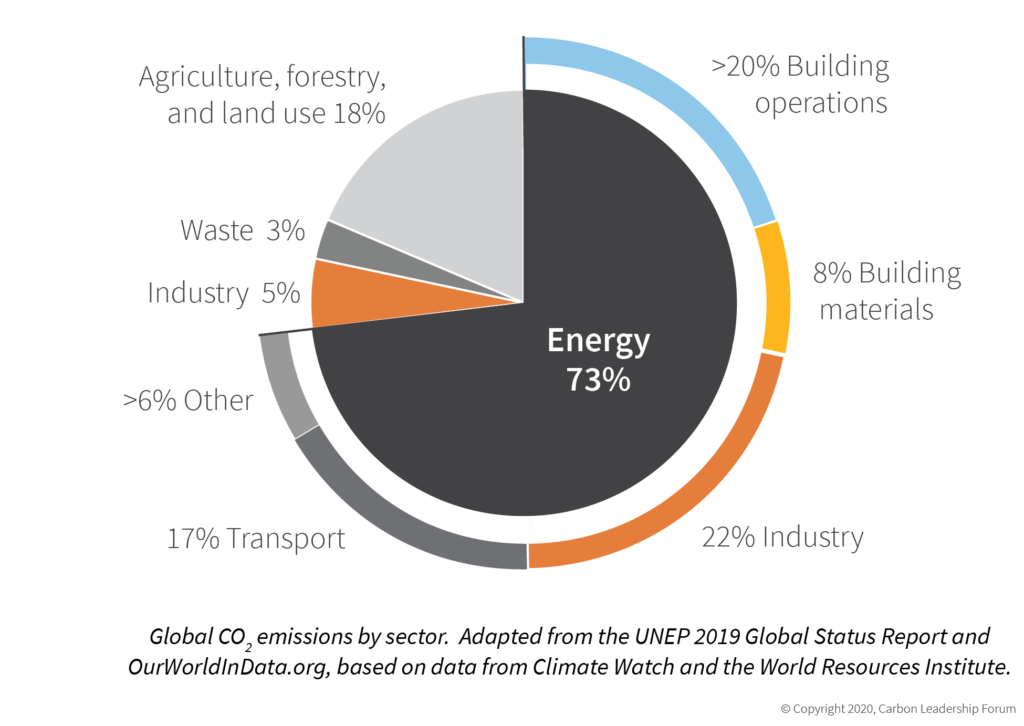Version: 17 décembre 2020

Figure 1. Carbone incorporé (jaune) et carbone opérationnel (bleu) à travers les étapes clés du cycle de vie d'un bâtiment.
Comprendre le carbone incorporé
Mesurer le carbone incorporé
Dans le bâtiment, carbone incorporé fait référence aux émissions de gaz à effet de serre résultant de la fabrication, du transport, de l'installation, de l'entretien et de l'élimination des matériaux de construction. En revanche, carbone opérationnel fait référence aux émissions de gaz à effet de serre dues à la consommation énergétique des bâtiments.
Afin de quantifier les émissions de gaz à effet de serre et leurs effets potentiels sur le changement climatique, les scientifiques utilisent une méthode appelée analyse du cycle de vie (ACV) pour suivre les émissions produites tout au long du cycle de vie d'un produit ou d'un processus. Ces émissions sont converties en paramètres qui reflètent leurs effets potentiels sur l'environnement. L'une de ces mesures est potentiel de réchauffement climatique (GWP), qui est quantifié en kilogrammes d'équivalent CO2 (kg CO2e). Cette quantité est également communément appelée un empreinte carbone.
Le carbone incorporé est un problème urgent
Selon le Accord de Paris, afin d'éviter une trajectoire de changement climatique irréversible et catastrophique, les températures mondiales moyennes ne doivent pas augmenter de plus de 2 ° C. Puisque (1) les émissions s'accumulent dans l'atmosphère et (2) qu'il reste peu de temps avant l'arrivée de ce point de basculement, les émissions libérées maintenant sont plus critiques que les émissions rejetées plus tard.
La majorité du carbone incorporé total d'un bâtiment est libérée dès le stade du produit au début de la vie d'un bâtiment (voir la figure 2). Contrairement au carbone opérationnel, il n'y a aucune chance de réduire le carbone incorporé avec des mises à jour d'efficacité après la construction du bâtiment. Il est urgent de s'attaquer au carbone incorporé maintenant pour atteindre les objectifs climatiques à court et à long terme. Pour plus d'informations sur ce concept, consultez La valeur temporelle du carbone.
Figure 2. Impact relatif du carbone incorporé et opérationnel d'un nouveau bâtiment de 2020-2050. Les sources de données: Étude de référence sur le carbone incorporé et Enquête sur la consommation d'énergie des bâtiments commerciaux (CBECS), en supposant un immeuble de bureaux commerciaux de taille moyenne. Suppose une décarbonisation progressive du réseau à zéro d'ici 2050.

L'empreinte mondiale du carbone incorporé
Environ 30% de toutes les émissions mondiales de carbone sont attribuées au secteur du bâtiment, avec au moins 8% résultant de la fabrication de matériaux de construction (voir figure 3). Un pourcentage supplémentaire des émissions mondiales peut être attribué au carbone incorporé des secteurs de l'industrie et des déchets.
À moins que nous ne prenions rapidement des mesures pour réduire les émissions liées à la fabrication de matériaux de construction, ces émissions continueront d'augmenter en raison:
- Augmentation de la demande mondiale de matériaux de construction pour répondre à la croissance démographique, en particulier dans les villes
- Remplacement d'une infrastructure vieillissante, qui aux États-Unis représente un investissement d'environ $4,6 billions, selon Bilan 2017 de l'ASCE pour l'infrastructure américaine
- Diminution de la proportion relative des émissions provenant de l'exploitation des bâtiments à mesure que l'efficacité énergétique des bâtiments continue de s'améliorer

figure 3. Émissions mondiales de CO2 par secteur. Adapté du Rapport de situation mondial du PNUE 2019 et OurWorldInData.org basé sur les données de Climate Watch, le World Resources Institute. Les émissions de matériaux de construction se produisent également dans les secteurs Industrie et Énergie> Industrie.
Stratégies politiques pour lutter contre les émissions industrielles
Les émissions industrielles nécessitent de nouvelles stratégies
Deux des plus grandes sources d'émissions du secteur industriel sont (1) la production de ciment et (2) la production de fer et d'acier (IEA). La réduction des émissions de ciment et d'acier nécessite une approche unique car la production de ces deux matériaux comprend:
- Réactions chimiques qui directement émettent du dioxyde de carbone; et
- Processus énergivores nécessitant une chaleur très élevée et (souvent) une combustion sur site de combustibles fossiles.
Une transition réussie de fabrication propre nécessite donc des stratégies qui vont au-delà des réductions d'énergie pour envisager une gamme de stratégies de réduction et d'élimination des émissions de carbone.
Si la réduction du carbone incorporé dans les bâtiments commence par une action dans le secteur industriel, l'industrie de la construction joue un rôle clé en créant une demande du marché pour des produits à faible émission de carbone. Les politiques publiques et privées peuvent à la fois envoyer un signal aux fabricants qu'il est temps d'investir dans des solutions à court et à long terme.
Remédier à la faille du carbone
Les politiques d'achat sont un levier clé pour intégrer une gamme plus large de stratégies de réduction et éviter la faille carbone. le échappatoire au carbone est une lacune politique qui permet à une région de réduire les émissions sur papier en externalisant ses émissions de fabrication dans une autre région. Environ 25% d'émissions mondiales sont incorporées dans les biens échangés qui traversent cette faille (KGM & Associates et Global Efficiency Intelligence).
Cette faille existe parce que les émissions sont généralement attribuées à leur pays d'origine ou à leur emplacement. Cette méthode laisse l'emplacement de la source pour suivre et réguler les émissions d'un produit, ce qui se traduit par un avantage économique injuste pour les produits à plus forte teneur en carbone fabriqués dans des pays avec des politiques environnementales moins avancées.
Pour encourager la réduction des émissions plutôt que l'externalisation des émissions, les politiques devraient se concentrer sur la mesure et la réduction du carbone incorporé dans la conception et la construction des bâtiments.